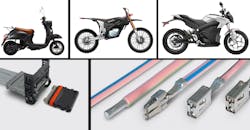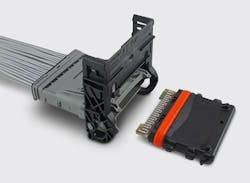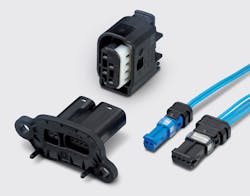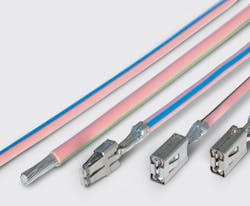Can Connectors Guide Motorcycles into a Low or No-Emissions Fast Lane?
Emission regulation compliance adds complexity and reliability elements to designs. The developing e-bike market creates new connectivity challenges, requiring new solutions. Designers need to look carefully for the best inter-connect solutions in today’s harness and wiring designs to ensure new emission standards are met. In addition, two-wheeled vehicles often see faster design cycles, so maintaining safety and sustainability must be considered.
From a sustainability point of view, Connectors can enable a greener, more fuel-efficient future through the use of connectivity solutions for ECU/EFI, hybrid and electric applications, start-stop systems, and on-board diagnostics.
Designers of two-wheel vehicles—such as e-bikes, motorcycles, and scooters—meet new emission regulations by adding electronic sensing and control systems. As two-wheelers move to battery-driven powertrains, designers must place the highest priority on sealing, electrically shielding, and physically protecting the quality of their signal and power connections.
Emission Regulation Upgrade
When the European Union put out its stricter Euro 5 and Euro 6 emissions directives, it became clear that motorbikes would increasingly need to turn to electronic control units (ECUs) to meet and stay in compliance.
Compared to Euro 4, Euro 5 and Euro 6 impose tighter limits on emissions such as carbon monoxide, unburned hydrocarbons, and oxides of nitrogen from exhausts. Euro 5 equivalent starts in Taiwan in 2018, and is required in Europe and Japan by 2020. In India, the government is determined to jump to Euro 6 equivalent directly from Euro 4 in 2020 to reduce air pollution. China will implement Euro 4 equivalent in 2019, which is also a significant improvement. New and registered vehicles will need to be equipped with electronic fuel injection systems as well.
The impact of the changes required to be compliant with the new regulations should be considered in light of the total worldwide market production for motorcycles, which was estimated at 53 million units in 2018. India and the Asia-Pacific market made up around 95% of the total market. This translates to significant electronic content upside with upgraded sensors, relays, on-board diagnostics (OBDs), ECUs, metering, wiring, and tubing to meet the required emission regulations and differentiation features.
TE Connectivity’s SmartSeal connector features a rugged, compact design with a lever slide lock mechanism that secures the connector to an electronic control unit (ECU).
The many connectors and cables must be robust enough to ensure long-term signal and power integrity in the face of extremely harsh environmental and stressful mechanical operating conditions. Motorbike designers are already aware of the delicate nature of electronic devices, boards, and connectors relative to their mechanical counterparts. As such, they have learned to choose their connectors and route their cabling carefully, accounting for wide temperature ranges (−40 to 135°C), vibration, rain, and humidity.
TE Connectivity’s NanoMQS solutions support the need to reduce weight and space in two-wheel vehicles.
Electric Two-Wheelers
While designers of internal combustion engine (ICE) motorcycles work to meet compliance requirements, another, more-organic trend has consumed the two-wheeler market: the rise of electric motorbikes and e-bikes. These are being adopted rapidly worldwide—and not just as ICE motorbike replacements or for push-bike assist, as some cases are providing consumers an alternative to four-wheel passenger vehicles.
E-bikes have one unique advantage over passenger vehicles in that users can pedal if the vehicle runs out of battery power. They have other advantages, too: E-bikes are smaller and easier to maneuver than passenger vehicles, which is useful on congested roads. They also cost less, and pedal-assist e-bikes encourage users to ride bikes who might otherwise be concerned about their ability to cycle long distances.
Advances in e-bike electronics and control are also helping in their adoption. For example, smoother motor-control algorithms and the use of microelectromechanical systems (MEMS) -based accelerometers and gyroscopes have led to improved handling and balance with electronic stability controls. The placement of the motors and battery compartment has also improved balance with a lower center of gravity. Yet, proximity to the ground makes the battery and motor more susceptible to water ingress and mechanical shock, making the choice of connector particularly important.
This importance rides atop the already demanding current-handling properties of e-bike connectors and relays, which must be able to carry or switch between 10 A and 2,000 A at voltages of up to 750 VDC, compared to 12 or 24 VDC for combustion-engine two-wheelers.
Added Features, Push Connector Density, and Signal Integrity
The emission regulation upgrade and the move to e-bike coincides with users’ demands for the integration of more multimedia entertainment, sensing, display, and navigation systems on top of the basic two-wheeler platform. This combination of signal density and high power can compromise an electronic control system over time, a situation that is only going to get worse as more electronics are added to smaller chassis.
To meet the needs of next-generation two-wheelers, designers need to consider their connector, sensor, and harness options early in the design cycle. With design requirements changing rapidly, it may be wise to find and partner with a supplier knowledgeable in standards compliance requirements, and with the breadth of experience to provide a more holistic approach to system design, safety, reliability, and efficient signal and power routing.
To handle the increased pin density, for example, connector vendors have already developed a single connector with higher pin densities for analog or digital signals, with sufficient isolation to allow co-location of power rails.
Many of these connectors are available off-the-shelf and are adequate for most applications. However, in situations where a more advanced or custom connector design is required, a good connector and harness partner/supplier will already be tuned to the customers’ needs and should be able to dispatch a team to develop a solution quickly.
TE Connectivity’s LITEALUM wire-crimp termination enables a seamless, stable, and secure solution for aluminum wire in motor vehicles.
Given the fast-changing design environment of modern two-wheelers, having a highly technical connector, sensor, relay, and cable harness team available to provide design insight and rapid turnaround of custom connectors can make or break a design. This is especially true when it comes to safety, sustainability, and innovation.
Specifically, being able to connect safety applications such as visual detection, ABS, and anti-theft systems when and where they are needed most ensures that rider safety is not compromised due to lack of technical connector knowledge.
From compliance to safety and sustainability, next-generation two-wheelers are on the leading edge of electro-mechanical system design, making it critical that designers be confident in their connector partner’s technical and innovation capabilities.
For more information, visit TE Connectivity.




